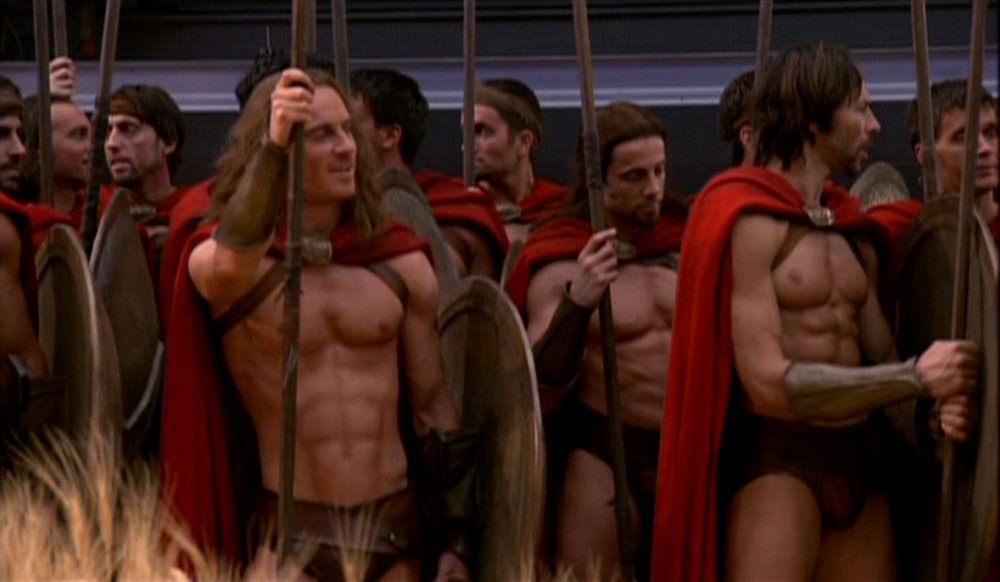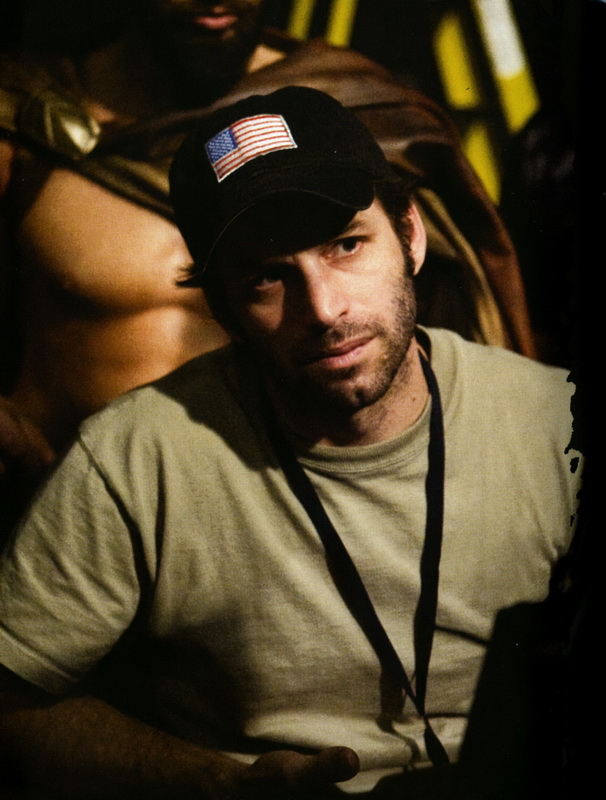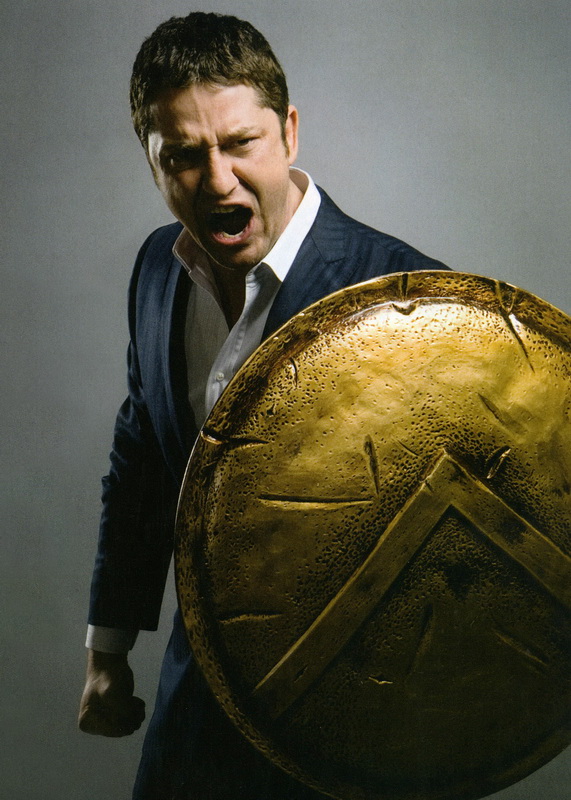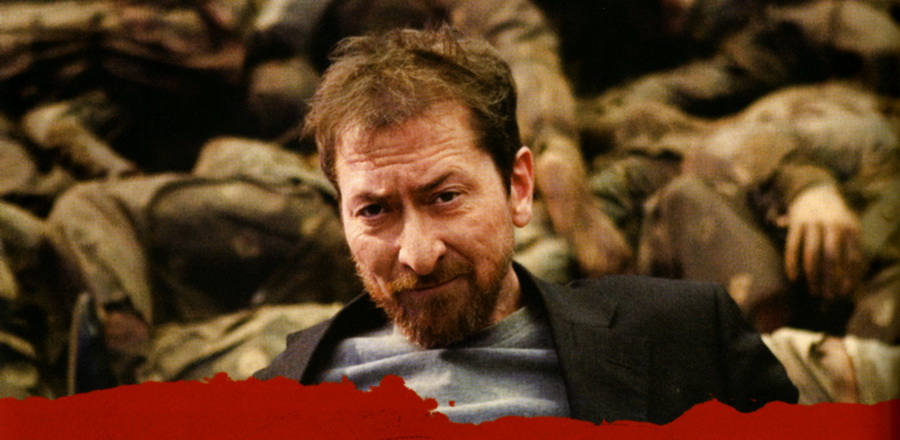
|

|

|

|

|

|

|

|

|

|

|

|


Think you're hard enough?
The creator of Sin City. The director of the Dawn of the dead remake. The toughest warriors the world has ever known. 300 could redefine the historical epic as we know it...
A horde of snarling, silver-masked monsters surges forward, deformed hands clutching huge scimitars, clawed feet pounding down a hill.
Before them, sandals planted firmly in blood-spattered sand, stands a handful of men, each clad only in a bronze helmet, crimson cloak and groin-hugging loincloth, somehow managing to project an air of nonchalance despite the oncoming horrors. The armies clash, the defenders ripple forwards, swords and spears flickering and suddenly the masked brutes are somersaulting back wards, skewered by the blades or crushed be huge shields. Just as the attackers scramble to rally and push again, a voice rings out above the fray: "Cut!" This is the tumultuous world of 300.
Based on Frank "Sin City" Miller's graphic novel of the same name, 300 is director Zack Snyder's follow-up to his surprisingly successful Dawn Of The Dead remake. But this time Miller isn't dealing with bat-suited Dark Knights or the outer extremites of noir. Set in Greede in 480BC, 300 relates the epic and very true tale of the Battle Of Thermopylae, at which a tiny Greek force, led by 300 elite Spartan warrior (aka 'hoplites') and their grim leader, King Leonidas, held off an army of 250,000 invading Persians intent on bringing all of Greece under the rule of "King of Kings" Xerxes during three days of fierce fighting.
It's one of the key moments in the history of Western civilization the world would arguably be a very different place if the Spartans hadn't held out for so long but if what Empire's just witnessed is anything to go by, this is no Alexander or Troy, no pompous history lesson enlivened by the occasional peroxide barnet. This is history as refracted through the twisted mind of Frank Miller, with all the stylish exsess you'd expect from the creator of Sin City.
And like Sin City, the filmmaker's prime concern has been to stick as closely to the sharp, distinctive look of Miller's graphic novel (which does for blood-red and bronze what Sin City did for black-and-white) as possible. Which is precisely why "Empire" is witnessing the above carnage while shivering on a sound stage in a former railway shed in Montreal in December, instead of enjoying the heat of coastal Malta during the summertime.

"Absolutely Theres too much violence!" Zach Snyder, director.
"For long time we talked about the City of the lost children, Lemony Snicket route, with giant sets and forced perspective," says Snyder as he stands in the shadow of a wall of festering corpses, piled up by the Spartans as a grisly barricade.
"Only recently has the technology reached a point where we can do all this digitally. It allowed us to keep it design-y and... Our film's serious heart-attack serious but there is a style to it that allows you to have a bit more irony and a little more fun."
Surely Snyder's on to something here. The likes of Troy and Alexander ate up huge budgets getting casts of hundreds out to location in Morocco, Malta, etc. All he has to do is gather his forces in a sound stage, with far fewer props all far less logistically headachey than the usual historical-epic approach.
"Is this now the only way to make these big, epic films?" he muses. "I don't know it was right for us, but right for another movie? It certainly worked out cheaper, but that's because we had a particular style.
It's as if we took real-life events and made them mythological, the way it would have been told around the camp fire. This isn't a time machine back to ancient Greece; it's a storyteller's story. We want it to look like a drawing, and in the visual-effects world that's vastly different from making it look like stone-cold reality."
To prove his point, Snyder invites Empire on a tour around the art department. Here, reality has indeed been checked at the door. Images from the graphic novel are pasted all over the walls, usually handing next to matching storyboard sketches and near-identical finished shots. The movie's distinctive look involves taking Snyders originally-shot images and digitally "crushing" then in post-production. "We basically crush the blacks, highlight the whites and amp up the contrast in the mid range," explains production designer Jim Bissell. The mutes the bright colours of the set into the golden, muddy tones of Miller's book, giving the finished product an almost watercolour feel. So closely has the film stuck to the graphic novel. In fact some of its blood splatters were actually scanned in to be duplicated precisely on celluloid.
Of course, this does mean that the actors including Gerard butler as Leonidas, David Wenham as soldier Dilios and Rodrigo Santoro as Persian god-emperor Xerxes have to bark their speeches and swing their weapons against green screens, with only their imagination to fill in the blanks. Those blanks include an army of million Persians (Miller taking ancient Greek historian Herodotus' exaggeration of the numbers literally), huge swathes of precipitous coastal landscape, a sea battle and the majority of the 300 Spartans most days, there are only about 40 present, a mixture of actors and professional stuntmen.

"There was a large amount of suffering and vomit." Mark Twight, trainer
Ah, the Spartans, reading Miller's graphic novel, one of the first things you notice about his take on these formidable warriors of the ancient world is their attire. Or Rather, the lack of it.
Ignoring the usual uniform of sculpted breastplate and leather skirt, Miller decked his hoplites our in, at most, a jockstrap, a cloak and a few leather strips. You might have assumed Snyder would immediately revert to the more traditional Gladiator-style look (which is more historically accurate) but barely a moment after arriving on set, it becomes apparent he hasn't, as well-toned extra wanders past Empire towards the catering tent in what is essentially a leather loincloth.
"It's not a loincloth it's a codpiece, goddamn it!" Gerard Butler is mock-indignant as Empire tries to define exactly what he's been wearing although to the Canadian weather. "Aw, how can I defend 'loincloth' with 'codpiece'? I had some issues with it at start, but not anymore. The first time I tried it on, I didn't even have my cape on just trainers, black socks and this leather codpiece and I could see the smirks and I was dreading month of this. But the funny things that now they don't blink an eye I don't think about it.
And when you work out so hard you're suddenly proud of the way you look. Im pretty much happy to walk around naked every chance I get, because as soon as this movie finishes it'll all disappear again!"
The, ahem, Spartan wardrobe meant the film's physical trainer had to be tougher and more ruthless than most drill sergeants to get the cast those perfect bikini bodies. Mark Twight, a former professional mountaineer and current consultant for US Army Special Operations, was called in to put Butler and co. (plus the admirably game Snyder, who also trained with him every morning) through a grueling three month, exercising up to six hours a day in non-air-conditioned room in Los Angeles.
"Rule One was, 'No-one gets hurt," Twight tells us, grinning in a slightly scary way. "We broke Rule One a few times... There were groin pulls and a couple of spains, a large amount of suffering and a fair amount of vomit. But everybody was supervised and nobody was really incapacitated. Anyway, I presume there's insurance for that.."
The pain and its resulting gain weren't just for show. They're essential for the correct representation of the Spartan ethos; this was, after all, a country of professional soldiers, an entire nation dedicated to kicking ass and taking names.
"In some ways, these heroes are more like villains," says Butler. "These guys absolutely think they're going to win, but even if they die, they'll treat that as a win because they're doing what they're built to do, what they love. It's always frustrated me when, in a film, I've wanted thehero to hit the bad guy and he didn't; he just sent him to prison. And I'm jumping up and down and shouting, 'No! Kill him! Cut his balls off. I love that he's hero that pushed the definition of hero to the very edge."

"The Spartans'code comes from a darker world." Gerard Butler
"You have to understand, these people were all slaveholders," adds Frank Miller, on set to cheek on Snyder's progress (his verdict? "I'm in love"). "There were 15 slaves to every Spartans citizen. Because they're the heroes of my story I try to make them look as good as I can, but I wouldn't want to have dinner with any of them. It's a wonderful paradox about Spartans they made possible a wonderful civilization they could never kill the messenger, but the Spartans callously kill Xerxes' ambassador at the beginning of his story. It was considered blasphemy to do something like that. But the Spartans didn't give a damn."
Miller's admiration dates to a formative moment in his childhood. "It's the best story I ever got my hands on," he explain. "I was seven years old, and I sow this clunky old 1962 movie called The 300 Spartans. Towards the end, I asked my dad: 'Dad, are the good buys gonna lose? "I'm afraid so, son.' I watched the end of the movie, and the course of my creative life changed. Because all of sudden I understood that heroes aren't the guys who you could tell at the end Harry Potter getting cheered by his goddamn classmates. They're people who did the right thing, whatever the consequence. And ever since then, heroic sacrifice has been a theme of my work. I put on one shot of Thermopylae in Sin City, in The Big Fat Kill, like a dog marking his territory, but I waited until I thought I had the skills to pull it off."
"I think Frank's gods his Leonidas, his Batman, his Mary are basically the same guy: happy to kill you, with a very narrow tolerance for bullshit," says Snyder. "The Spartans are nuts, they throw their kids off cliffs (being proto-eugenicists, they dropped any physically imperfect babies down a gorge). Frank told me that he may write a follow-up to 300 where the Spartans are the bad guys. But on the other hand, when you go against a million you kinds want those guys with you."
Butler, uniquely qualified to comment as Nut-in-Chief, agrees. "Their code comes from an older, darker world. But you really get behind them, because you respect that toughness they have. If they're going to do something, there's no stopping them. They'll finish it off."
Up against this fearsome warrior cult is an enemy to worry even the most gung-ho of Greeks, Santoro's nine-foot-tall Persian emperor Xerxes and his millionman army.
The Persians of the day believed that their emperors were semi-divine, so Miller and Snyder amping up the mythology, exaggerated his scale, draped him in gold chains and precious stones and set about making him "sexy but twisted", reclining at the end of a hard day on a bed of human beings arranged for his comfort.
"I wanted Xerxes to feel like a man who, whatever was available in the world, he had it," says Snyder. "So we added a bit more elephants, and these giants with no arms and tattooed midger archers on their shoulders. It's a bit of a freak show, this cool montage of weirdness that he throws at the Greeks. In Xerxes'tent there's a goat-headed minstrel, because, well, that just seemed like something you'd see in there."
"I actually had a problem with the studio over our concept of Xerxes, because he's not really the bad guy. He's the perfect mix of menacing and kind, masculine and feminine you can't pin him down. He's not in his tent, laughing maniacally and stabbing a map of Greece. He doesn't even appear until the second act. He's cartoonish, but not cartoon villain. I mean, the whole movie, Xerxes just keeps making Leonidas these great offers if he'll just kneel. But of course it's something that Leonidas just doesn't know how to do."

"Heroes do the right thing, no matter what." Frank Miller, creator
And thus begins the great-grandmother of all battles another beneficiary of Snyder's green-screen approach. "I think the fighting scenes being done in a more controlled environment really allowed for far more spectacular stunts," reckons Butler, "because you're not in rough terrain; you're not falling down holes and breaking your ankles. It was still dangerous, but not as dangerous, so we could go further."
If there's one thing that everyone involved is clear on, it's that 300 isn't going to skimp on he bloodshed. "Absolutely there's too much violence!" laughs Snyder. "There's a sort of surrealness to it, and I did that on purpose. Am I looking for balanced by blood spraying here and some more here? Awesome! The blood's part of the painting. If you want more red, you just got to hack another guy open and get some over there!"
Fountains of claret, perfectly toned warriors hacking and slashing in what might as well be their birthday suits... It's all sounding rather, er, testosteronal. Snyder agrees, which is why he decided to add a dash of oestrogen to Miller's original story, boosting up the character of Leonidas'queen, Gorgo (Lena heady), who battles on the homefront to get some reinforcements sent her husband's way.
"Frank had her in the book, so we just gave her a little bit more to do. She becomes the reminder of why we fight, what's at stake. It was really a matter of, 'Should we have someone other than a bunch of guys in leather bikinis running around?' I was just exhausted by all these abs..."
"It's like in Xerxes'tent I added a few more dancing girls. We were all turning day," Snyder deadpans, "and I had to do something to stop it, for my wife's sake!"
